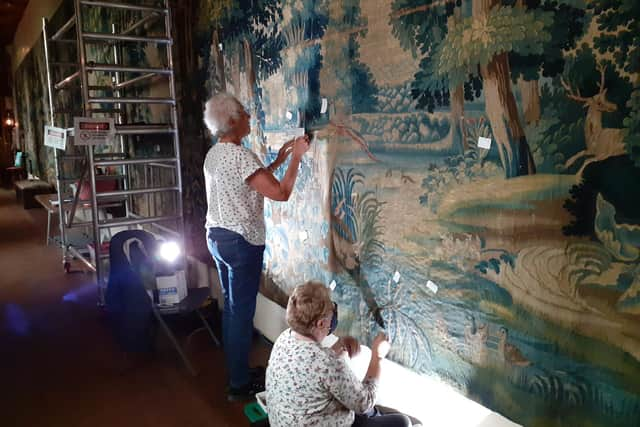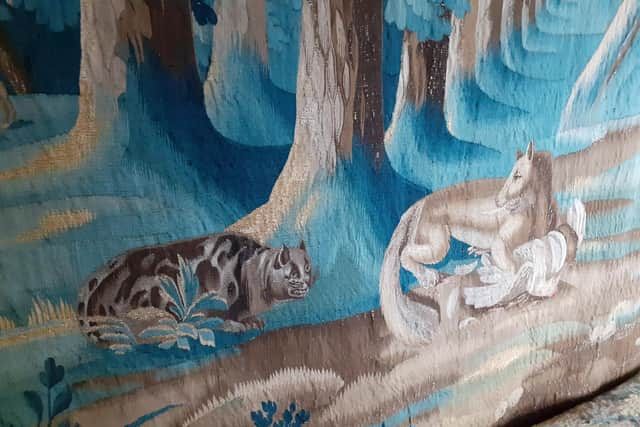Tapestry that hangs in Mary Queen of Scot's 'happy place' undergoes painstaking conservation
The tapestry, which hangs in the Royal Gallery at Falkland Palace and is made up of six pieces, was made in Flanders in the 17th century.
It depicts imagined hunting scenes and was bought to reflect the palace’s history as a Royal Hunting Lodge, where Mary Queen of Scots is said to have enjoyed some of her happiest days.
Advertisement
Hide AdAdvertisement
Hide AdThe conservation of the tapestry has been ongoing for several years.


The material was sent to the renowned De Wit Studio in Belgium in 2018, where 100 years of dust from soot and open fires was washed away, reinvigorating lost colours.
But the way the vast works – which feature hunters, rabbits, wildcats and stags – have been hung over time is now causing areas of damage.
Lesley Scott, conservation advisor at National Trust for Scotland (NTS), who covers the Edinburgh and East Region, said: “There are now weak areas in the tapestry that are taking the strain."
She said the underlying problem was the way the tapestry was constructed, with tapestries hung on their weakest axis, the continuous horizontal warp threads.


Now the weakened fibres of silk and wool are being strengthened with delicate, dyed patches of netting being sewn into the piece.
The conservation work is being led by Sophie Younger, a textile conservator based in Perth, who is repairing the larger tapestry panels as they still hang on the gallery wall.
She is being assisted by two-long standing NTS volunteers with textile expertise.
Advertisement
Hide AdAdvertisement
Hide AdThe history and story of the tapestry have been researched by Antonia Laurence Allen, NTS regional curator east, and Marietta Crichton Stuart, the daughter of the former keeper of the palace, Michael, who appointed the National Trust for Scotland as deputy keeper in 1952.
The tapestry set has been at Falkland Palace since 1906 and was originally purchased to hang in the Chapel Royal, which was being furnished to function as the local Catholic Church.
Lord Ninian Crichton-Stuart, former keeper of the palace and father of Michael, agreed to pay £1,532 18s for the tapestries – about £200,000 today – after going to view the pieces, probably in a house in Utrecht.
They had been recommended to him given their hunting theme.
Antonia Laurence–Allen, regional curator, Edinburgh and East, said: “As early as the 12th century, there had been a hunting lodge on the ground and it later became a Royal Hunting Ground, with the Renaissance palace built by James IV and V.
"It was the favoured palace to go hunting for Mary Queen of Scotland and she had some of her happiest days here. Most of the plots around Scotland associated with Mary are linked to her tragedy, but not here.”
Falkland Palace became the family home of Lord Ninian’s son Michael and his wife following World War Two and later handed over the management of the visited side of the palace to National Trust for Scotland in the 1950s.
A message from the Editor:Thank you for reading this article. We're more reliant on your support than ever as the shift in consumer habits brought about by Coronavirus impacts our advertisers.
If you haven't already, please consider supporting our trusted, fact-checked journalism by taking out a digital subscription.
Comments
Want to join the conversation? Please or to comment on this article.